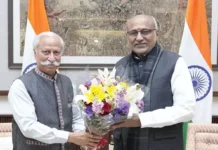ITANAGAR, 8 Feb: Against the background of China’s plan to build a ‘super hydropower dam’ on the Yarlung Tsangpo river in its 14th Five-Year Plan (2021-25), New Delhi-based international affairs observer group Red Lantern Analytica (RLA) organized an expert panel webinar on the topic ‘Decoding China’s hydropower strategy: Threats, challenges and responses’ on 6 February.
The panel featured former union minister and current MLA Ninong Ering, and the list of speakers included research professor of Latin American studies at the US Army War College Dr Evan Ellis; geopolitics and international relations expert from MAHE Dr Dhansree Jayaram; assistant professor at Jindal Global University Dr Sriparna Pathak; and senior journalist from The Dawnlit Post, Ranju Dodum.
Addressing the webinar, Ering stressed on the need for adequate attention to the ‘water bomb’ being engineered by China against India by building many dams on the Tsangpo and other tributary rivers in occupied Tibet. He argued that “the ecological imbalance created in the Brahmaputra basin region of India will be huge, and addressing this issue is the need of the hour.”
Ering referred to various recent instances of floods in Arunachal, the most devastating being in 2017, when the whole Siang river turned black due to alleged Chinese activities. He expressed concern over the Chinese tactic of using the river as a medium to keep India in check “while the official communist propaganda mouthpiece of China, the Global Times has reported on plans to divert whole rivers in the occupied Tibet region to the Xinjiang region of China.”
Dr Ellis spoke about the various projects the Chinese Communist Party’s infrastructure-building companies have been working on in the hydropower sector in countries like Argentina, Ecuador and Cuba, and added that various security breaches have been observed in these projects from time to time.
He highlighted that “various Chinese companies and their contracts are being terminated and given to other companies due to multiple failures in the construction of hydropower plants.”
Dr Pathak made a presentation on China’s habit of using ecological features like rivers as a political tool to dictate terms to its neighbours.
“A prominent instance in this respect came in 2017, when China refused to share hydrological data with India during the Doklam standoff,” Dr Pathak said.
Emphasizing that infrastructure development in the Himalayan ranges is fraught with danger as the region experiences regular seismic activity, she said that the Indian government should to voice its concern regarding “Chinese weaponization of rivers” in international forums.
Dodum spoke from a journalistic point of view. “Lack of communication between India and China has led to various conflicts in the past and may also result in a wider escalation in the future,” he said.
He said the two countries should engage in dialogues regarding activities in the Siang river which directly affect the population living in the Brahmaputra basin area and beyond.
Dodum spoke about the need for “journalistic limelight” to be given to Arunachal and the plight of its people due to floods becoming an annual affair due to Chinese activities upstream.
Dr Jayaram spoke about the planned projects by China, “which are already having an ecological consequence on India.” She emphasized that India should develop technologies to help in fighting off adversities later on.
She also spoke on the “large-scale weather modification project of China to alter the weather of a large geographical part of China and occupied Tibet.” She said China either bypasses or refuses to comply with international laws and treaties and is using its upper hand on natural resources as a bargaining chip in maintaining relations with its neighbouring countries The remarks were followed by a question and answer session, covering various questions raised by the audience. The questions included the US’ policies towards China and Tibet, and its stand with regard to India and China.



